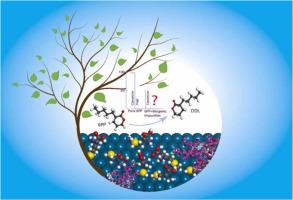Journal of Environmental Chemical Engineering ( IF 7.4 ) Pub Date : 2022-01-04 , DOI: 10.1016/j.jece.2022.107132 K.V. Haseena 1 , Madhulika Gupta 2 , Adarsh Madhu 3 , Atul Narang 4 , Md. Imteyaz Alam 1 , M. Ali Haider 1

|
Integrated biological and chemical catalysis as a sustainable solution to produce chemicals and fuels has received considerable attention in recent times with a prospect to add-up new routes for chemical synthesis in a futuristic biorefinery. The fundamental challenge ahead of this is perceived to be catalyst deactivation from biogenic impurities that arrives from fermentation broth. Herein, model experiments on hydrogenation of a bio-renewable platform chemical, 6-amyl-α-pyrone (6PP), is designed by incorporating model impurities such as alanine (Ala), arginine (Arg), cysteine (Cys), methionine (Met), and bovine serum albumin (BSA). Interestingly, 100 ppm of sulfur-bearing impurities such as Cys and Met in the reaction significantly decreased reactant conversion. Ala does not affect the 6PP conversion, while Arg is observed to cause a moderate reduction in the conversion. A mechanistic route for catalyst inhibition from impurities is modeled using density functional theory (DFT) simulations. It is observed that the adsorption of Cys amino acid on the Pd (111) surface is followed by dissociation into atomic sulfur. In large proteins like BSA, several disulfide linkages are present. Interestingly, molecular dynamics (MD) studies reveal the spontaneous alignment of up to three disulfide linkages of BSA protein on the Pd (111) surface, elucidating that the disulfide linkages present in the protein play a crucial role in facilitating interactions with the Pd (111) surface. However, BSA did not show any substantial changes in the catalyst activity, which may be due to the structural complexity of the protein that inhibits its diffusion into the active sites on the catalyst.
中文翻译:

了解生物可再生平台化学品转移氢化过程中生物杂质对催化剂的抑制作用
近年来,综合生物和化学催化作为生产化学品和燃料的可持续解决方案受到了相当大的关注,并有望在未来的生物精炼厂中增加化学合成的新途径。在此之前的基本挑战被认为是来自发酵液的生物杂质使催化剂失活。在此,通过引入丙氨酸 (Ala)、精氨酸 (Arg)、半胱氨酸 (Cys)、蛋氨酸等模型杂质,设计了生物可再生平台化学品 6-戊基-α-吡喃酮 (6PP) 的氢化模型实验。 Met) 和牛血清白蛋白 (BSA)。有趣的是,反应中 100 ppm 的含硫杂质如 Cys 和 Met 显着降低了反应物的转化率。阿拉不影响6PP转换,而观察到 Arg 会导致转化率适度降低。使用密度泛函理论 (DFT) 模拟对杂质抑制催化剂的机理路线进行了建模。可以观察到,Cys 氨基酸在 Pd (111) 表面上的吸附之后是解离成原子硫。在像 BSA 这样的大蛋白质中,存在几个二硫键。有趣的是,分子动力学 (MD) 研究揭示了 BSA 蛋白在 Pd (111) 表面上多达三个二硫键的自发排列,阐明了蛋白质中存在的二硫键在促进与 Pd (111) 的相互作用中起着至关重要的作用。 ) 表面。然而,BSA 没有显示出催化剂活性的任何实质性变化,











































 京公网安备 11010802027423号
京公网安备 11010802027423号